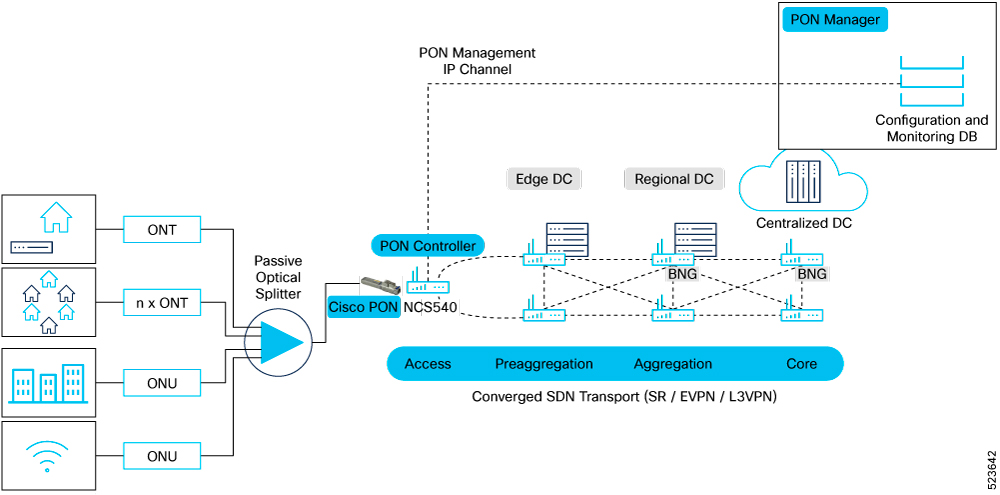Components of the Cisco Routed PON Solution
The Various components of the solution are:
Cisco PON pluggable OLT
The Cisco PON pluggable OLT features a hot-swappable SFP+ design that enables the deployment of a software-defined broadband network. It incorporates a 10G Ethernet to XGS PON MAC Bridge IC along with a Layer 1 optical transceiver. This integration facilitates the module's connection from a PON network to a dedicated Ethernet SFP+ port on routers. The system is capable of supporting 10G data transmission speeds both upstream and downstream.

Technical specifications of the Cisco PON pluggable OLT are:
|
Dimension (H x W x D) |
8.55mm x 13.4mm x 80.65mm |
|
PID |
SFP-10G-OLT20-X |
|
Data rate |
Symmetric rates: 8G upstream/8G downstream |
|
Connector Type |
SC/UPC |
|
Maximum Distance |
20 km |
|
Operating Temperature |
-20°C to 75°C |
|
Typical Power Consumption |
3.2W |
|
Average Launch Power |
4 dbm min 7 dbm max |
|
ODN Class |
N2 |
|
Cable Type |
Single Mode Fiber |
Cisco PON Manager
The Cisco PON manager is a web application and an accompanying REST API that provides a graphical user interface for managing the PON network. The PON manager is used to set up the OLTs and ONUs, as well as downloading firmware updates for both the OLTs and ONUs. The REST API accompanies the web application for the purposes of providing access to MongoDB for managing PON users and the PON network. The PON manager facilitates:
-
Alarm management
-
Dashboard view
-
Device monitoring and statistic
-
Device provisioning and management
-
Service configuration
-
User management
-
Database management
MongoDB database
The MongoDB datastore contains all of the configuration, state, statistics, alarms, and logging data for the devices in the PON network. Northbound interfaces, such as the Routed PON Manager and the customer applications interface with MongoDB to provision and retrieve monitoring information for devices in the PON network. MongoDB serves as the interface between the PON Manager and the PON Controller.
Cisco Routed PON Netconf Server
The Cisco Routed PON Netconf Server features a Netconf-compliant interface and an API that allows clients to manage PON networks effectively. Built on Netopeer2 and ConfD, the server provides robust configuration management and connects to a MongoDB database for operational data handling. It complies with the Broadband Forum's TR-383 and TR-385 YANG models, ensuring the server can configure subscriber services reliably within the PON network infrastructure.
Cisco PON Controller
Cisco PON Controller is a light-weight application which runs as a docker container on each NCS540, NCS 5500, and NCS 5700 devices. Various configurations applied to the OLTs and ONTs in the network are fetched from the MongoDB database and provisioned on the OLT ONUs by the PON Controller. At each polling cycle, the PON controller collects state information, statistics, alarms, and logs from devices and reports the information to higher layer applications through MongoDB.

 Feedback
Feedback